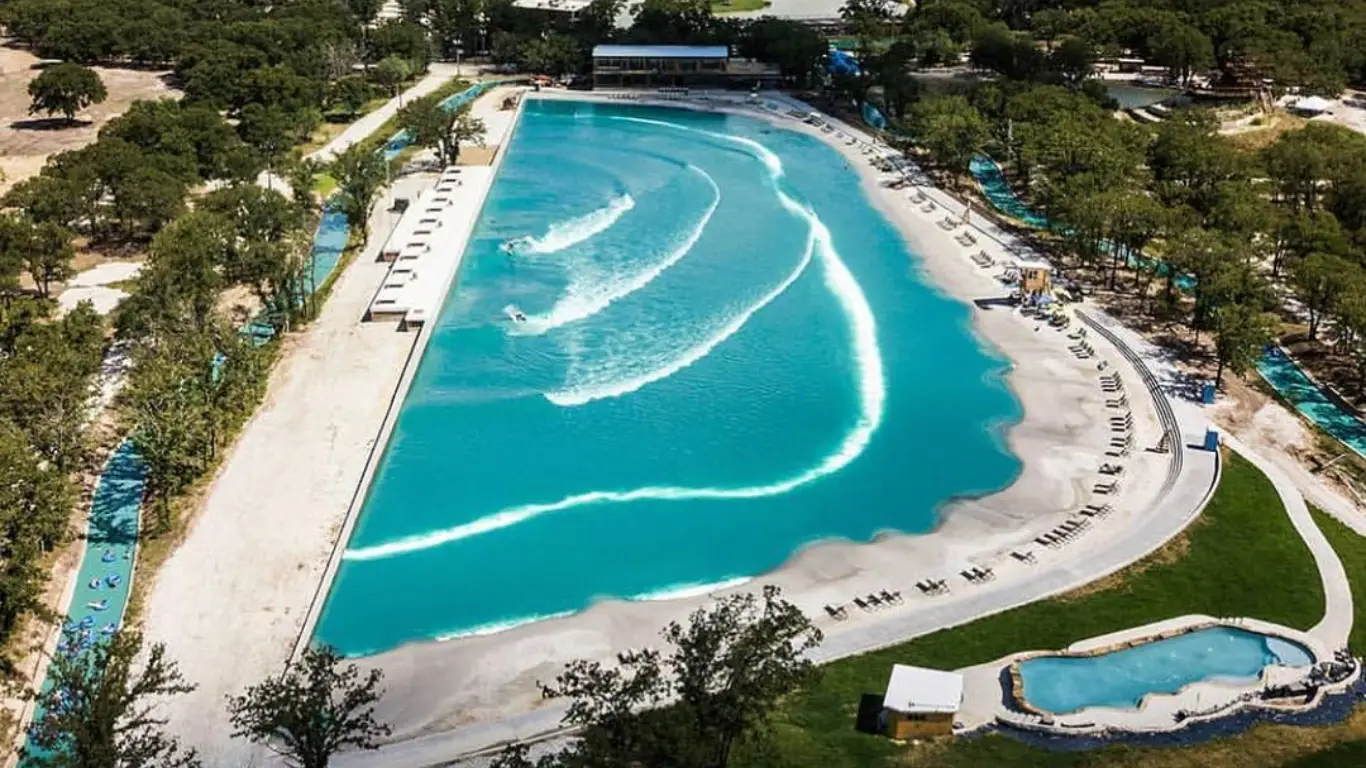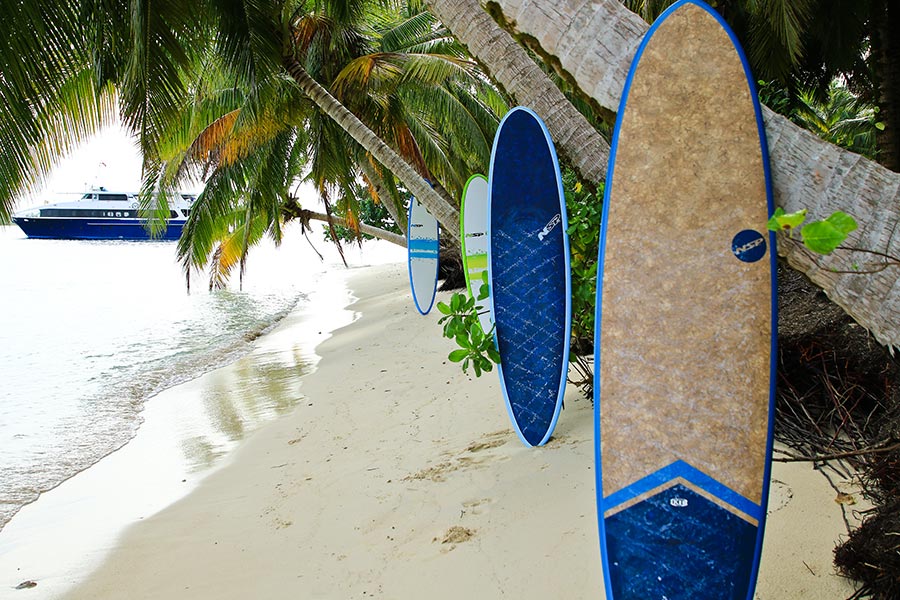Wave pools in 2019
updated Tuesday 8.01.2019
Kelly Slater’s Wave Company buys NLand Surf Park
Towards the end of last year, World Surf League (WSL), majority shareholders of the Kelly Slater Wave Co., quietly purchased the struggling Texas Surf Park.
As mentioned further down in the article, all current manufacturers are still working out kinks and NLand was no different. Strapped for investor cash, several surf parks have skimped on the concrete for the wave pools. And while this is acceptable for a proof-of-concept or a private facility, NLand was a wave pool open to the public.
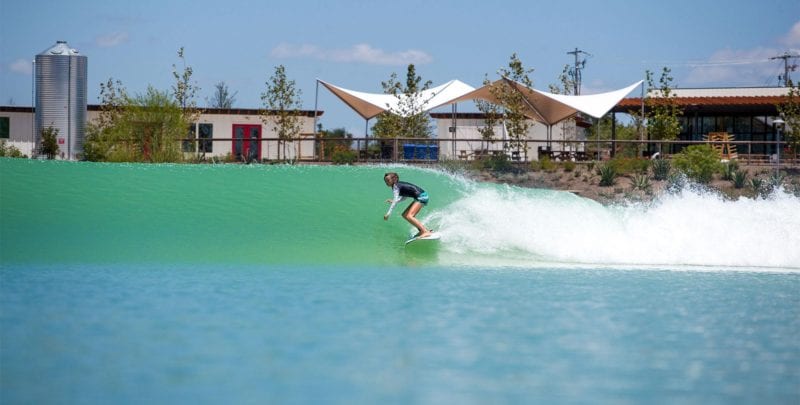
Under the stress of regular usage, NLand Surf Park closed because of essential damage to its concrete lake and only reopened six months later, mirroring some of the start-up troubles Snowdonia went through (the other Wave Pool using Wavegarden technology).
Doug Coors, the surfer/financier who stood at the cradle of the project in 2015 is rumoured to have clashed repeatedly with county officials over safety issues until late 2017.
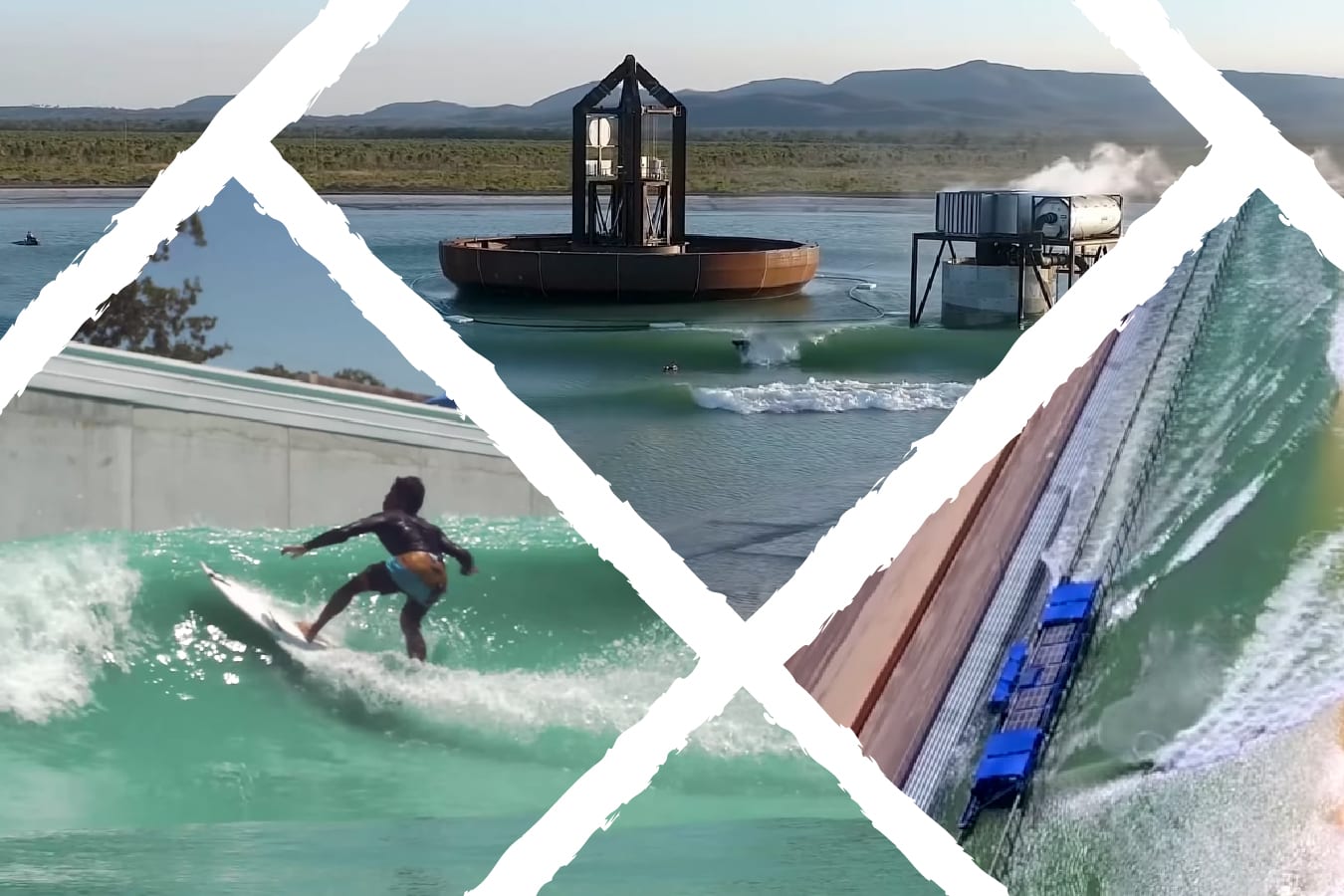
30 min. read
By now, anyone with a modest interest in boardsports has noticed the developments in wave pool technology. There are videos, spy videos, PR videos and basically, 2018 has been the year of the wave pool. Today, there are several companies on three different continents, and they all seem to perform a delicate balancing act.
Eager to hype their concept, attract investors and show off the accomplishments of their prototypes, these companies release well-produced videos, invite TV-crews or even host the occasional competition. But on the other hand, all the technology involved is immature and developing fast. So the key companies remain tight-lipped about their exact setup or desired business model. With BSR, Snowdonia and NLand being the exception, most next-generation wave parks are either closed or severely restricted to the general public.
More rides than you can imagine
Regardless of your opinion, know this. Wave pools are starting to show some very interesting numbers. Even the staunchest purist will admit that any spot dishing up more than ten solid rides in under an hour, all on overhead waves, qualifies as “legendary”.

I’ve made a quick table comparing the different wave pools with each other, with additional info on the different pools below. The reason why I picked these six is because they’ve consistently made the headlines over the last three years.
How do they stack up?
| Wavegarden | Surf Snowdonia | NLand | Surf Ranch | BSR Surf Resort | Surf Lakes | |
| Accessibility | Demo site | Open to public | Open to public | Demo site | Open to public | Demo site |
| Location | Northern Spain | Wales, UK | Austin, Texas | Lemoore, California | Waco, Texas | Yeppoon, Australia |
| Technology | Hydrofoil & Cove | Hydrofoil | Hydrofoil | Hydrofoil | Cove | Tsunami Plunger |
| Operational facilities | 3 | – | – | 1 | 1 | 1 |
| Cost | – | 24 – 50 USD per hour | 60 – 90 USD per hour | 55.000 USD a day | 60 USD per hour | 30 – 50 USD per hour |
| Ride duration | 20sec | 20sec | 20sec | 45-55sec | 8-10sec | – |
| Wave size | 5ft | 5ft | 5ft | 6.5ft | 6ft | 7ft+ (!?) |
| Waves per hour | – | 80 | 80 | 14 | 120 – 150 | 2400 |
| Capacity | – | 50 people at once | 50 people at once | 1-2 people at once | 9-20 people at once | 200+ |
While everything looks very tempting and I am as excited as the next guy about finally riding a proper man-made wave, there must be downsides that those slick videos don’t show.
But let’s go back in time, because artificial waves have been around for much longer, with the first commercially viable pool back in 1929 in Munich, Germany. That’s nearly a century ago…
As a kid, I remember bopping up and down in wave pools with my friends and family, but they were designed for swimming. Built as a unique selling feature for family-friendly water parks, artificial wave pools were meant to thrill and entertain in a safe way. I am not even going to get into flowboarding or stationary waves because they offer a very compromised experience at best, and at their worst, they have very little to do with surfing.
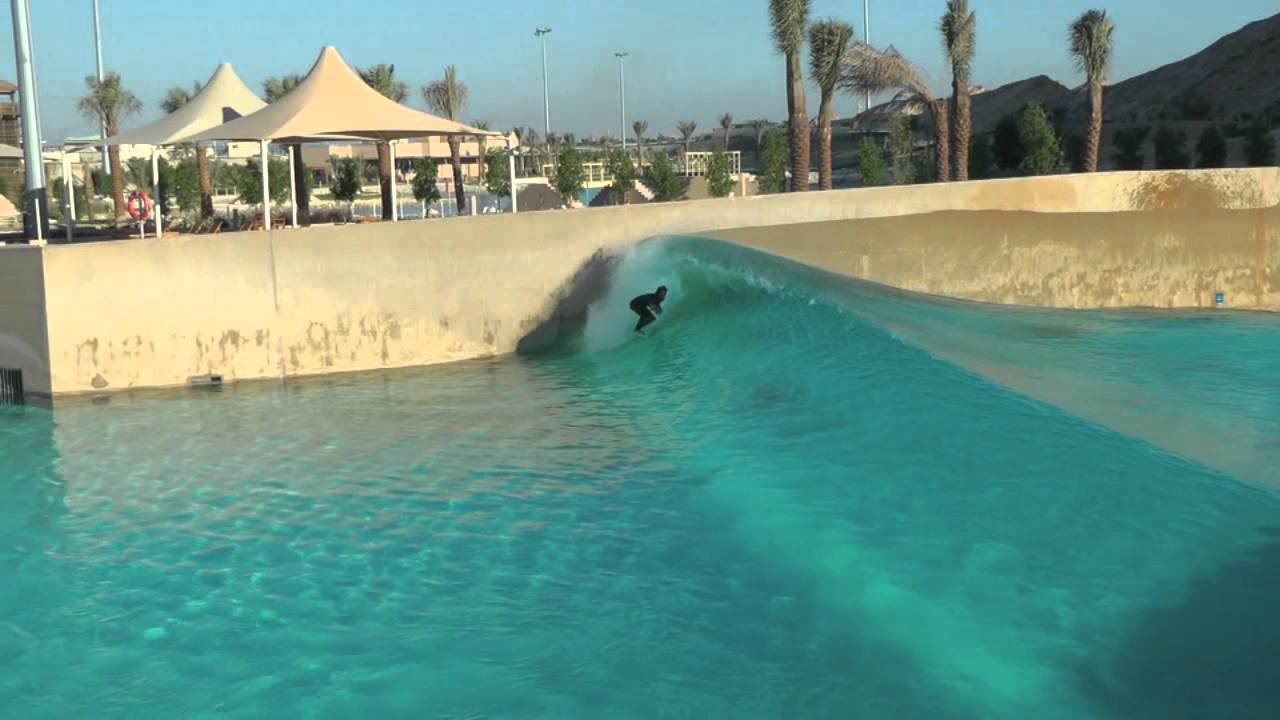
The first wave that looked like it offered a genuine ride popped into my conscience was Dubai’s Wadi Adventure Park. When they hosted an invitational event in 2013, their pool looked like it actually made a decent-size wave – it could even be surfed!
In retrospect, it is easy to make an empty wave look good with a bunch of paid pros. Regular visitors who made it out to Wadi as well complained about the price, the crowds, the bad management and the very few waves they were allowed to ride for the money that they paid.
Enter the Wavegarden
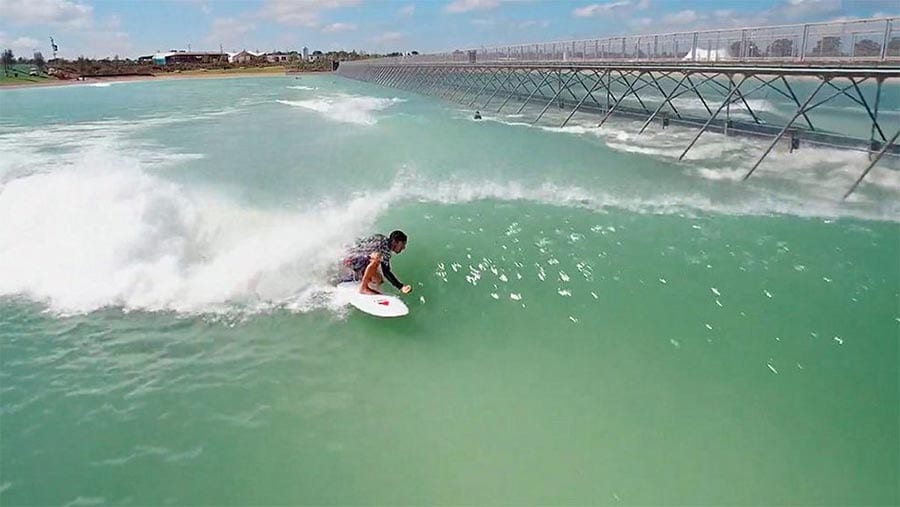
This is why the Wavegarden 2.0 video (June 2013) was a big deal. Moving beyond the tarp/pond proof of concept from their first videos, they managed to present a new wave-making technology that was meant for surfers, not for families looking for a swim.
For the first time, we got to see long and consistent waves (15-20 seconds). Accommodating both regular and goofy riders, a single surfer could suddenly catch more waves in a day than they could possibly catch in a month. The Wavegarden, with its characteristic shape and netting promised a longer ride than natural waves, an advanced- and a beginner area and an ideal learning environment.
WAVEGARDEN SUMMARIZED
The original Wavegarden in Basque country has always been a research facility. Entry is per”invitation only” and it currently features their initial (small-scale) Wavefoil setup with a right-hander and a left-hander and their more recent “Wavegarden cove”.
With two operational Wavegarden facilities open to the public, Surf Snowdonia in Wales and NLand in Texas, and many more in development, Wavegarden has the most experience in designing, building and exploring artificial surf facilities. Wavegarden has also announced additional projects starting in Barcelona, Madrid, Costa del Sol, Edinburgh, Bristol, London, Melbourne, Sydney, Perth, New York, Miami, Santiago, Marrakesh, and Tel Aviv.
Meet Kelly’s wave

Long after the initial buzz surrounding Wavegarden, Kelly Slater presented his own version of a wave-making company in 2015, aptly named the Wave Company and the entire industry was blown away by a wave with the size and consistency that previously seemed impossible.
Surfers who discuss the Surf Ranch casually throw around the word “perfection” and in many ways, Kelly’s wave really fits that bill. Its development team, aware of even the tiniest of changes in local conditions, have calibrated their pool to a point where they can adjust their wave to something as little as a change in sidewind.
In future competitions, this will be a key component in making sure every contestant gets to ride the very same wave. It’s all very impressive but when people talk about Kelly’s wave, the low capacity of the Surf Ranch is often overlooked.
Its machines currently produce a mere fourteen waves an hour. Given the frequency of waves some of the other wave-making companies claim, it may be difficult to run a profitable business with these numbers in the long run.
Regardless, the World Surf League purchased a majority stake in the Kelly Slater Wave Company, so expect the Surf Ranch to be put to good use. There are rumours of private membership, and given that most people who have surfed there so far are either celebrity, surf royalty or billionaires, the idea isn’t that far fetched.
The above video explains the potential of the Surf Ranch, but also demonstrates another aspect really well. A Football quarterback flies in with a private jet, and through coaching by the GOAT himself, six months of learning to surf is squeezed into a single day. Golf carts, jet skis and wave shapes customized for a single person are very different from what the other wave pools offer their clientele.
Maybe it is safe to say that Kelly’s Wave Company is about making the perfect wave for a single person. It is not about putting as many people as possible on that wave.
KELLY SLATER’S SURF RANCH SUMMARIZED
In most articles and videos about the Ranch, a lot of weight is given to the work of Adam Fincham, a fluid mechanics specialist. But it really shows in the results; the height, the steepness of the wave, its consistency, barrel and peeling angle are all unsurpassed. A single ride can take up to 50 seconds and the wave can be over 2 meters tall (6ft). In terms of “rider experience”, Kelly has built the perfect wave.
Sophisticated foil technique generates what’s called a soliton. a single, very rideable wave that goes from end-to-end. After every wave, the pool has to stop to let the water settle, after which the hydrofoil is pulled the other way. There are engines on both sides, pulling the foil through the water with a force of 4000 horsepower. The facility is not open to the public and given its very low frequency of waves (after every ride, the pool needs three minutes just to settle down) it will be hard to exploit this facility commercially.
WSL holdings, now the majority shareholder, has already announced they will not sell rides at Surf Ranch. Instead, they will focus on hosting pro contests and building additional surf parks with hotels, concert venues and retailers.
I think of the Surf Ranch as a “boutique” wave, reserved for a few (lucky) people who get to ride a wave that is perfect for their level of surfing. I am also convinced that the technology will trickle down to other venues and should become available to a wider audience at one point. Kelly Slater, arguably the greatest surfer of all time, set about creating the greatest mechanical wave of all time. Uncompromised by investor requirements, he did just that.
Don’t mess with Texas
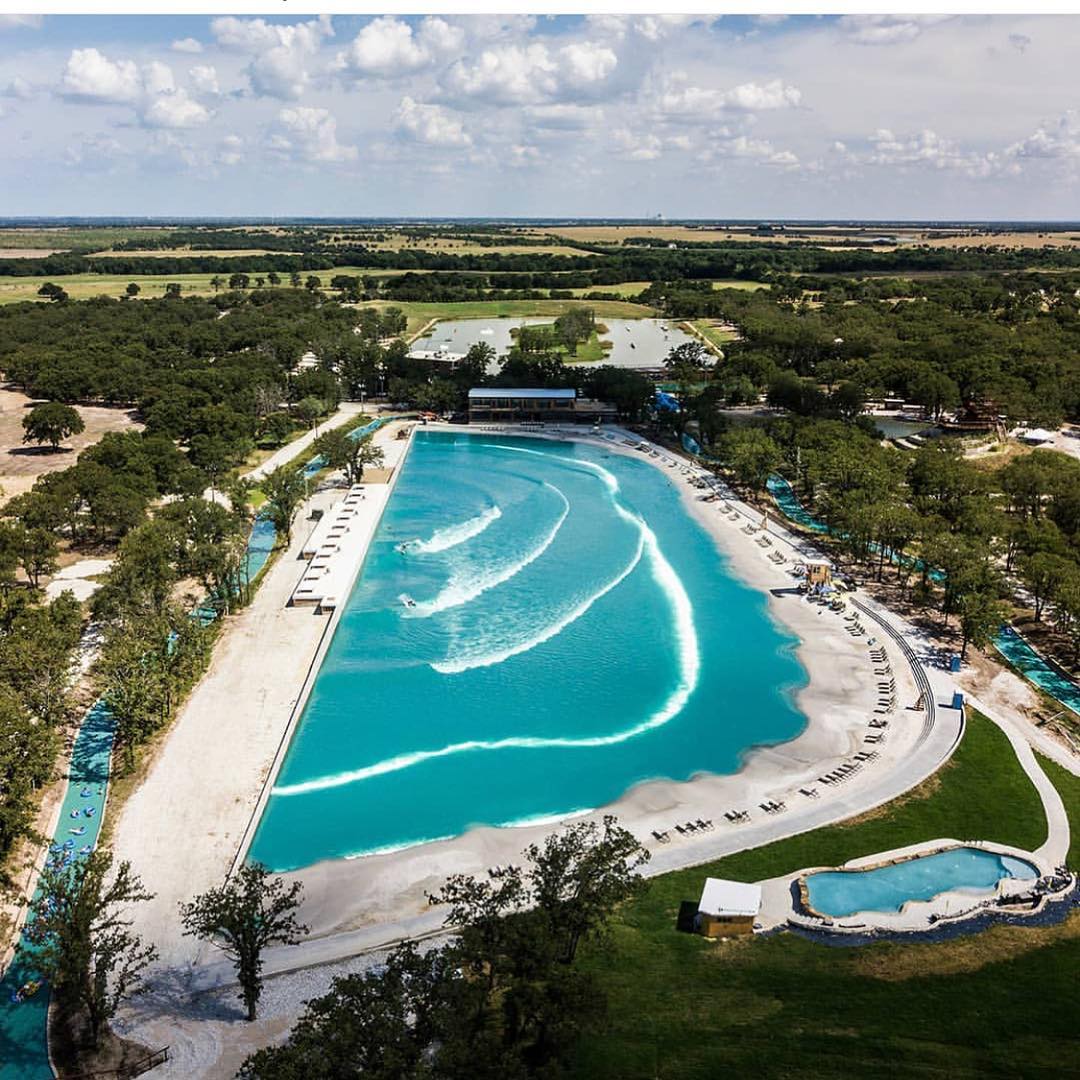
Shortly after the Surf Ranch broke the surface, BSR presented their wave pool to the world, and it was a completely different concept. Where Kelly’s wave was criticized for being unnaturally perfect, the breaks at BSR were said to have a more natural feel to them and be less predictable. What’s more, the different mechanics of their wave pool allowed for quicker adjustment of their waves.
With the swell seemingly appearing out of nowhere, and the unusual angles from the earlier videos, the BSR Wave generated a lot of questions. Is that water color normal? How long can people ride these waves? What’s its capacity? BSR opened up to the public almost immediately though, and from what its visitors posted online, more details emerged.
The goo-like appearance of the water is caused by artificial coloring. Management wanted to avoid the pool taking the same color as the concrete that it’s made of so they opted for a light green.
Clearly designed to accommodate more people than just a single rider, the BSR Pool won’t create a barrel like the Surf Ranch. And even though it doesn’t dish up barrel perfection, it certainly produces some serious waves. So while the Australian National team booked the Surf Ranch for their Olympic training, the US surf team announced they would partner up with BSR instead:
USA Surfing head coach Joey Buran:
“The technology allows repeat, made-to-order waves that are perfect for training. With the capacity to produce three waves per minute at 12-second intervals and different wave configuration at the push of a button from right point to left point to right point with a perfect air section, this wave offers USA Surf Teams the opportunity to train in an environment that closely mimics Ocean conditions.”
…Just in case you needed more proof that the war of wave pools is now a real thing.
With up to three breaks, BSR pool can accommodate nine of these junior athletes in its “expert” setting, where the beginner setting allows twenty people at once to ride a wave. But it’s a different experience entirely; think longboards. an ankle-slapper and riding in a straight line.
Seeing the content that comes from the different wave pools, it’s almost funny how the Instagram feed of American Wave Machines is stacked with air shots, while the Surf Ranch seems to upload barrel after barrel.
BSR SUMMARIZED
BSR in Texas is different than the other contenders in many ways. Firstly, the wave pool is the latest attraction in BSR Cable park, meaning it is part of a bigger operation. And secondly, their pool doesn’t make use of the hydrofoil technology that both Wavegarden and the Surf Ranch use.
And there must be something to their technology, because since its opening, Wavegarden has expanded its Spanish facility with another installation called the Wavegarden Cove that seems to operate similar machinery.
In every piece of PR about BSR and Wavegarden, both manufacturers always point out the variable character of their wave, plus the higher frequency of waves per hour. So it seems that an operator who prioritizes profit over the perfect ride is likely to invest in “Cove” technology.
But according to Surf Lakes in Yeppoon, Australia, both technologies produce rookie numbers on their best days. To take your wave pool from double to triple digits for waves per hour, concentric waves is where it’s at.
Surf Lake’s “Tsunami Plunger”
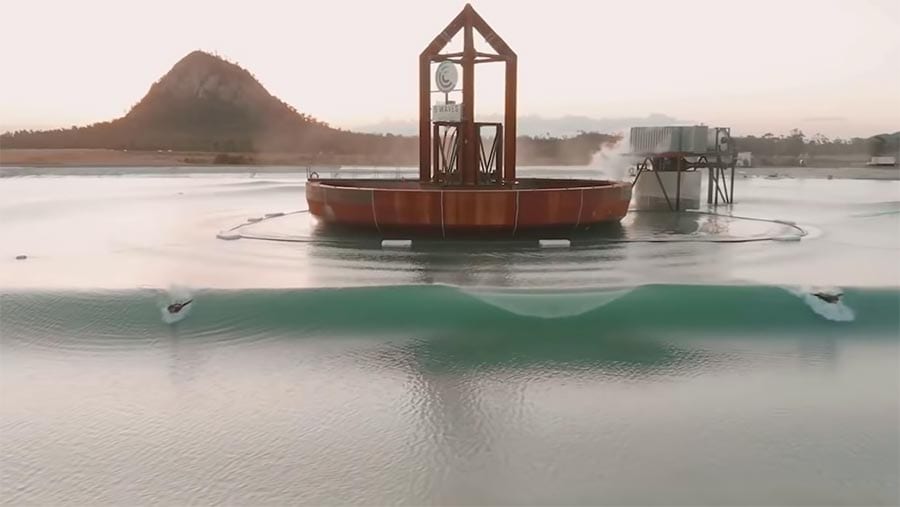
Right of the bat, Surf Lake’s wavemaking machine is the weirdest looking one by far, and yet you immediately “get” the concept. With most of the machinery above the water surface, the mechanics are easy to understand. Firstly, two or three strokes of the plunger displace enough water to generate a concentric wave.
Surf Lakes then capitalizes on this setup by creating not one but five breaks around their installation. The interesting aspect is that a single expenditure of energy generates many more riders all around it.
And to potential investors, this is a big win. The more surfers you can serve, the easier it becomes to run a profitable business. Currently, Surf Lake is not open to the public, but while NLand and Snowdonia charge approx. 90 USD per hour for an adult at peak times, Surf Lakes is confident they can do it at half the costs of their competitor.
Theoretically, a fully operational Surf Lake installation should be able to generate 2,400 rideable waves in one hour. So with 240 boards in the water, everyone should be able to get in ten rides an hour. Show me a crowded break that can beat those odds.
Only a carefully selected group of (potential) investors and journalists has visited the site, and during the final day of its presentation, a key component blew up, suggesting the technology is still months away from being a commercial product.
You can clearly see the waves growing with every stroke of the plunger, but so far the machine has run just three consecutive strokes in a row. That’s half of the intended six needed.
SURF LAKES SUMMARIZED
Compared to the other manufacturers in the article, Surf Lakes promises to have the most capacity and (probably) the lowest cost per ride. But you can argue that the technology isn’t quite there yet. Their installation is still just a prototype, designed to attract investors and as a proof of concept. But even though their mishaps are well-documented, we think Surf Lakes has the technology to distrupt this very young industry at its core.
Imagine how big the waves will be once the engineers have their machine dialled in. Surf Lakes has announced that they will start construction of at least 2 commercial builds in 2019, with several other projects in locations like Arizona, California, Brazil, Spain, UK, Middle East and two in Australia.
A VERY YOUNG TECHNOLOGY
Developers are certainly paying attention and continue to create full-colour brochures, packed with interesting ROI numbers, turnover, annual capacity and buzzwords like “sustainability” and “renewable”.
Meanwhile, the few existing installations continue to rack up operation hours, learning a lot about maintenance costs, dissipation techniques, exploding valves and even brain-eating amoebas (?!).
But as more parks open, the technology will improve, costs will come down and everyday surfers will reap the benefits. Whether you are a beginner looking to improve yourself or a seasoned pro looking for a better training environment, surf pools will be an option.
WHAT YOU NEVER READ OR SEE IN THE VIDEOS
Current
You don’t really see this in the videos, but a wave pool running at full capacity will oscillate. Once engineers managed to generate sizeable waves, they quickly discovered that their biggest hurdle in creating consecutive waves is the current these waves generate. Several visitors report their initial surprise at just how much effort it takes to stay at the right spot, and you intuitively look for something to hold on to.
To counter this, existing wave pools are being retrofitted with drainage rosters and newer installations are designed with complex software that helps dissipation of the kinetic wave energy.
Noise
Most of the videos you saw from the different wave pools feature pro riders, fast editing and upbeat music. Those soundtracks do a great job masking the noise you find at a typical wave pool. Whether it is a PA system shouting instructions, the mechanics of the machine itself or ambient noise – a wave pool is much louder than your local break.
Pay to play
Ultimately, all wave pools need to make money, so if your #1 association with surfing is to rock up and be one with nature, think again. The pools currently open for business charge per hour and board rental, wetsuits, coaching or bootsies all cost extra. And I don’t think bringing your own food or beers is appreciated either.
It’s not like the real thing
Surfing inside a pool is rife with reminders that you are in an artificial environment. Sweetwater gives your board less buoyancy and especially on a shortboard you will be able to tell when you paddle in. Also, most of the waves are faster than real-world waves, giving experienced surfers a “WTF!” moment before they manage to tune into the required rhythm. Take off is different too, requiring a different line.
So what’s next for wave pools?
A blessing for beginners
Never mind the pros for now, going by the comments on Tripadvisor, wave pool visitors come in two radical camps. First, there are the beginners who are stoked about the entire experience. The friendly staff is praised, the learning experience is mentioned repeatedly, and between the lines, an overall enthusiasm oozes from their reviews. These are happy and grateful people, excited about an opportunity that they would never have experienced otherwise.
And then there are the regular surfers. Whether they were simply curious or desperately needed a fix, you can find them immediately by selecting all the one-star reviews on Tripadvisor or Google. They first explain that they are a surfer (“brâh..”), after which they complain about the waiting times, too many people in the water, the kooks, too few waves, expensive lockers, and the list goes on and on. My take is that they weren’t going to like it anyway. Wave pools are not for them.
Private vs. Public sessions
I know what messed up their expectations though. Most videos we see of wave pools are filmed during private sessions. This means surfers get to enjoy the pool on their terms without being told what to do, when to do it and when their time is up.
Operators will have to make a trade-off, either providing a perfect wave for a single rider and lose money in the process or try to put as many surfers in the water while guaranteeing everyone a ride at the same time.
Surf Lakes currently seems very close to a solution that can accommodate a lot of surfers simultaneously, while Kelly Slater’s Surf Ranch is more like a boutique-type wave pool, creating a perfect wave that goes on forever for one lucky surfer.
Given how very new and developing this technology still is, operators will continue to innovate and gravitate towards a business model that works best for their type of customer. Snowdonia, the longest running wave pool right now has experienced crippling maintenance costs and struggled with matching the right amount of staff and visitors while keeping costs down. So with staff being their biggest overhead cost by far, why not move to lower-income countries?.
Personally, I feel that if you are going to surf in a pool, it shouldn’t have to be in an 8mm wetsuit like in Wales. There are more temperate locations out there where labor costs are also significantly lower. Think Asia and/or South America.
And with tropical weather, expect night surfing or floodlights to be the next big thing. Asia especially has a cultural bias against tanning, so night time surfing is undoubtedly going to be big in these pools.
Regardless of these future developments, there are over 30 next-generation wave pools planned worldwide, so things are going to be good. The biggest win here is that surfing has become much more accessible to a lot of people.
Wavepools will grow the industry
There is no word that describes just how much corporate sponsors hate uncertainty. But an event manager who can guarantee perfect waves six months from now will have a much easier job securing funding. Broadcasting, getting prime-time slots and weeks of promos, all of that becomes a breeze as uncertainty is taken from the equation.
Shapers will create pool boards
Just like there surfboards designed for river breaks, shapers will design boards that work best in a pool environment. Board brands will jump on it too, coming to think of it 😉
Wavepools will grow surfing
With more (public) wave pools in various stages of development, becoming a surfer will be much easier than it used to be – a wave pool provides a much better learning environment than a natural break for beginners. Advanced surfers too will be able to benefit from a much higher frequency of perfectly identical waves.
Take Holland for example. It’s a tiny country by any comparison, and yet they boast six indoor skiing facilities, because the Dutch love to ski. Void of any mountains or a respectable winter season, the Dutch don’t like to learn while on holiday though. Instead, they practice their skills in a controlled environment, so their days on the slopes will be that much better.
I see a similar future for wave pools, where people not only go in preparation of their dream holiday, but also get to work on their style and enjoy the progression of their surfing. Locals at particularly prized spots may have to deal with more surfers, but let’s look at the bright side. Their skills set will be much higher, meaning less kooks to complain about.
Or maybe I am wrong, and surfers just really enjoy complaining 😉
What do you think? Like us on Facebook and comment on the post, or send us a PM of we’ve missed essential info on one of these pools. Expect this article to be updated regularly as more pools become operational.

